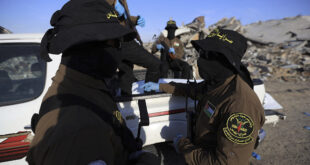NABATIYAH — From a hospital bed, 14-year-old Hassan tells how half his foot was blasted away by one of the million bomblets that Israel rained on south Lebanon during its war with Hizbollah.
“I ran across a small object hidden in the vegetation,” the teenager says from his bed in the southern town of Nabatiyah, as he struggles to come to terms with how dramatically his life has been changed.
But it could easily have been far worse for Hassan.
A 12-year-old child was killed and three others were wounded Wednesday when they triggered a bomblet while playing in a field in the Marjayun area, bringing to 15 the number of civilians killed by Israeli cluster bombs since an August 14 ceasefire.
The accidental explosions of the bomblets, some as small as a torch battery, have also maimed about 90 civilians, according to an AFP count based on United Nations figures.
The Lebanese army says that there are “possibly around one million” unexploded bomblets scattered over south Lebanon, most of which were dropped in the last days of the conflict.
The UN children’s fund (UNICEF) says one-third of the casualties caused by cluster bombs since the ceasefire in the July-August war between Israel and Hizbollah have been children, who often mistake the lethal devices for toys.
“This is a major problem,” said Soha Bustani of UNICEF in Beirut, adding the aim was to expand a public awareness campaign “to reach every single child in every single family”. Nabatiyah hospital director, Dr Ali Hajj Ali, has a grim warning: “The artificial limb technicians are going to have their work cut out for them in the weeks and months to come.” Since the UN-brokered truce, his hospital has admitted 24 people maimed by bomblets. Four people in the area have died, including two children from the Hattab family in a nearby village.
“Hadi and Mussa were playing in a field outside when we heard a dull thud. When we got there, the boys were spread out on the ground, lifeless,” said mother Sanaa, clutching a picture of 11-year-old Hadi to her breast.
Other hospitals in the region, especially around the port town of Tyre, have reported similar casualty figures.
The cluster bombs used by Israel contain hundreds of small but lethal bomblets, which are dispersed over a large area. Those that do not explode on impact turn into lethal anti-personnel mines.
UN humanitarian chief Jan Egeland in August said it was “completely immoral … that 90 per cent of the cluster bomb strikes occurred in the last 72 hours of the conflict” when it was clear a UN resolution was about to end it.
“… it is an outrage that we have … bombs among where children, women, shopkeepers and farmers are now going to tread,” he said.
Ibrahim Naim, who runs Al-Abbas laboratory where artificial limbs are fitted, said his centre has received two to three new patients a day since the end of the conflict that cost more than 1,200 people in Lebanon alone.
Artificial limbs, especially legs, are lined up against a wall at the laboratory.
The centre is run by a benevolent foundation funded by the Shiite group Hizbollah, whose capture of two Israeli soldiers on July 12 prompted the Jewish state to unleash its military on Lebanon.
Another Hizbollah association has set up a rehabilitation centre for the disabled and their families, called Al-Fardous (paradise), in Dweir, near Nabatiyah.
 Eurasia Press & News
Eurasia Press & News



